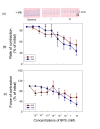Acute Exposure to Bisphenol S Decreases In Vitro Right Atrial Contractility in Rats
- PMID: 38292991
- PMCID: PMC10826249
- DOI: 10.7759/cureus.51387
Acute Exposure to Bisphenol S Decreases In Vitro Right Atrial Contractility in Rats
Abstract
Aim/objective: Bisphenols are widely used in the manufacturing of polycarbonate material and epoxy resins which constitute the essential component of plastic. Bisphenol A (BPA) has been reported to produce toxicity on organs in both animal and human studies. Therefore, plastic manufacturers are replacing BPA with other analogues that are considered to be safe, and BPA-free products are now available in the market. However, some studies have reported that bisphenol-S (BPS) also possesses toxic properties. It has been reported to depress ventricular contraction as well as produce ventricular arrhythmia on acute exposure. The present study was performed to examine the effect of BPS on in vitro spontaneously-beating right atria in rats.
Methods: In the present study, in vitro spontaneous contractions of right atria obtained from adult female rats of the Wistar strain were recorded. The atria were exposed to BPS (10-6-10 mM) and its effects on atrial contractions were recorded in the form of cumulative-concentration response with and without administration of antagonists namely atropine, L-NAME, and methylene blue.
Results: BPS decreased the rate as well as the force of atrial contractions. The changes produced in the rate and force of atrial contractions were not attributed to ethanol, which was used to prepare BPS solutions. The decrease in right atrial contractility produced by BPS was blocked by L-NAME; however, atropine and methylene blue were not able to antagonize the effects of BPS on atria.
Conclusions: The present study indicates the involvement of NO-dependent but cGMP independent pathway responsible for BPS-induced cardio-toxicity.
Keywords: atrial contractility; bps; cgmp independent; no; toxicity.
Copyright © 2023, Pant et al.
Conflict of interest statement
The authors have declared that no competing interests exist.
Figures




References
-
- Cutaneous penetration of bisphenol A in pig skin. Kaddar N, Harthé C, Déchaud H, Mappus E, Pugeat M. J Toxicol Environ Health A. 2008;71:471–473. - PubMed
-
- Increased migration levels of bisphenol A from polycarbonate baby bottles after dishwashing, boiling and brushing. Brede C, Fjeldal P, Skjevrak I, Herikstad H. Food Addit Contam. 2003;20:684–689. - PubMed
LinkOut - more resources
Full Text Sources
